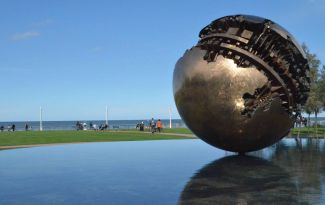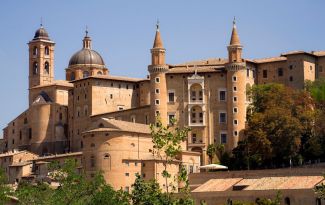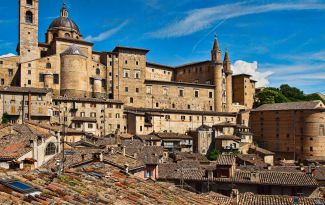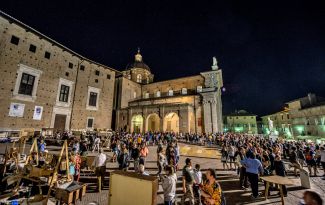In the footsteps of the ancient Romans
Urbino and the Montefeltro
Urbino is one of the most significant towns in the Marche region and Italy as a whole, renowned for its exceptional Italian art and architecture. During the 15th century, Urbino held one of the most illustrious courts in Europe, and the Ducal Palace of Federico da Montefeltro stands as one of the most exquisite examples of Italian Renaissance architecture. This palace is home to the Galleria Nazionale delle Marche, housing an impressive collection of paintings.
From Urbino, head northwest to Sassocorvaro, where you can admire the castle at the heart of the village. Continue your journey to Macerata Feltria to explore the medieval part of the town. Afterward, make your way to the charming town of Carpegna, famous not only for its stunning Renaissance palace but also for its renowned raw cured ham, Prosciutto di Carpegna.
Pesaro
The city of Pesaro, once known as "Pisaurum," held significant importance as a Roman colony. Following the Roman era, Pesaro, like much of Italy, endured a tumultuous history under various rulers, including barbarian invaders and Byzantines. Under the rule of the della Rovere family, Pesaro reached its zenith of prosperity.
The historic center of the town comprises picturesque streets lined with ancient palaces, churches, museums, and numerous intriguing libraries. Don't miss the Civic Museums, the main square with its Renaissance Palace, Rossini's House, the Oliveriana Library, the Villino Ruggeri, a gem of the Liberty style, and the mosaics at the Cathedral.
An interesting highlight is the bustling City Market held every Tuesday, along with the Antiques Market occurring on the third Sunday of each month. For those interested in shopping for clothing, the city offers hundreds of shops, many of which offer high-quality items.
Pesaro is also famous for its 7 km of sandy beaches and the enchanting San Bartolo Park, where land and sea merge to create a breathtaking spectacle along the Adriatic coast. Covering approximately 1600 hectares, the park boasts a well-organized network of trails. You can reach San Bartolo by car or bike via the scenic road starting in Pesaro. At the park's summit, visit Fiorenzuola and Casteldimezzo, charming medieval villages, and Colombarone, an important archaeological site.
Pesaro is best known for hosting the international Rossini Opera Festival every August. The festival showcases masterpieces by Gioachino Rossini, featuring singers and artists known worldwide, along with the International Festival of New Cinema.
Fano
Fano was originally a center of the Picena civilization and later became an important Roman town. It marks the terminus of the Via Flaminia, which connects Rome with the Middle Adriatic coast.
Known as Fanum Fortunae, Fano derived its name from the "Temple of Fortune," likely built to commemorate the Battle of the Metauro in 207 BC. During this battle, Roman legions defeated the army of the Carthaginian general Hasdrubal, ultimately leading to his demise.
The marble Arch of Augustus stands as the city's symbol, surrounded by well-preserved walls. These walls were initially constructed by the Romans, expanded in the fifteenth century by the Malatesta family, and later fortified by papal rulers around 500 AD.
The Palazzo della Ragione, located in the town's main square and dating back to 1299, houses the Theatre della Fortuna. Inside the Palace of the Malatesta, there is a beautiful city museum featuring a magnificent courtyard. The old town is replete with significant churches, including Santa Maria Nova, which houses a painting by the Perugino, along with several splendid ancient palaces.
Fano hosts a city market every Wednesday and Saturday, while an interesting Antiques Market takes place every second Saturday and Sunday of the month.
Accommodations in this area:

Castello di Granarola - Granarola, Pesaro

Ca' Maggetti - Urbino

La Loggia Historic Resort - Gradara








